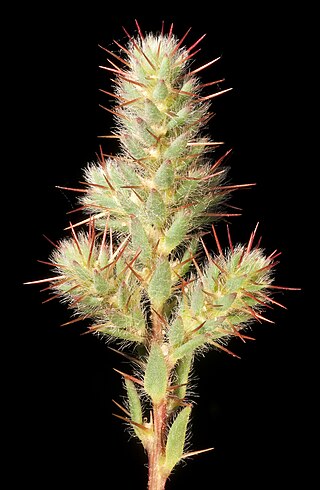
Atriplex vesicaria, commonly known as bladder saltbush, is a species of flowering plant of the family Amaranthaceae and is endemic to arid and semi-arid inland regions of Australia. It is an upright or sprawling shrub with scaly leaves and separate male and female plants, the fruit often with a bladder-like appendage.

Tecticornia arbuscula, the shrubby glasswort or scrubby samphire, is a species of plant in the family Amaranthaceae, native to Australia. It is a shrub that grows to 2 metres in height, with a spreading habit. It has succulent swollen branchlets with small leaf lobes.

Spyridium parvifolium, commonly known dusty miller, is a flowering plant in the family Rhamnaceae. It has dark green leaves and clusters of small, whitish flowers at the end of branches. It is widespread in eastern states of Australia.

Coprosma nitida, the mountain currant or shining currant, is a shrub species endemic to south-east Australia. It is a shrub with small, glossy leaves, occasional spines on the end of its branchlets, and small bright red-orange fruits.

Acacia gunnii, commonly known as ploughshare wattle or dog's tooth wattle, is a woody shrub which is endemic to south-eastern Australia found in dry heaths and woodlands. It ranges from Queensland, then New South Wales, Australian Capital Territory, Victoria, South Australia, down to Tasmania. Acacia gunnii grows to up to 1 metre high and has prickly phyllodes which are 4 to 15 mm long. The cream to pale yellow globular flowerheads appear singly in the axils of the phyllodes in June to October, followed by curved or coiled seed pods which are 40 mm long and 4 to 5 mm wide. Acacia gunnii grows up to 1 meter tall and has prickly phyllodes which are 4 to 15mm in length with cream to pale-yellow globular flower heads appearing in phyllode axils in June through to October, followed by curved or coiled seed pods which are 40mm long and 4 to 5 mm wide. The species was first formally described by English botanist George Bentham in the London Journal of Botany in 1842. It occurs in South Australia, Victoria, Tasmania, New South Wales, Australian Capital Territory, and Queensland.

Sclerolaena bicornis, commonly known as goathead burr, is a perennial shrub in the Amaranthaceae family, native to inland Australia, and found in Queensland, the Northern Territory, South Australia, New South Wales, and Western Australia The Walmajarri people of the Kimberley know the plant as Paka.
Calotis cymbacantha, the showy burr daisy, is a species of Calotis native to the arid areas of Australia. It is a perennial herb that grows between 10 and 40 cm tall. It has hairy erect stems which are woody at the base and produces yellow flowers.

Chenopodium spinescens is a species of plant in the family Amaranthaceae and is endemic to all mainland states and territories of Australia where it is known as Rhagodia spinescens.

Dissocarpus paradoxus is a shrub species of inland Australia, also known by the common names of cannonball burr or curious saltbush.

Sclerolaena fimbriolata is a species of flowering plant in the family Amaranthaceae, native to central Western Australia. A small shrub, it is typically found growing on the edges of gypsum salt lakes.

Sclerolaena cornishiana, the cartwheel burr, is a species of flowering plant in the family Amaranthaceae, native to parts of northern Australia. An annual or perennial, it is an intricately branched herb with solitary flowers.

Atriplex sturtii, commonly known as saltbush, is an endangered species within the widespread genus Atriplex.A. sturtii is a native Australian shrub and grows in the Channel Country bioregion, also referred to as 'Corner Country'.

Sclerolaena anisacanthoides, the yellow burr, is a species of flowering plant in the family Amaranthaceae, native to eastern Australia. A perennial rounded subshrub reaching 15 cm (6 in), it is typically found growing in heavy soils.
Sclerolaena divaricata, the tangled copper-burr, is a species of flowering plant in the family Amaranthaceae, native to southeastern Australia. A rounded perennial shrub, it has terete leaves.

Sclerolaena lanicuspis, the spinach-burr or copper-burr, is a species of flowering plant in the family Amaranthaceae, native to Australia. A woody perennial reaching 25 cm (10 in), it has tomentose branches and semiterete leaves.

Sclerolaena tetracuspis, the brigalow burr or dog burr, is a species of flowering plant in the family Amaranthaceae, native to eastern Australia. It is an intricately branched, sprawling perennial shrub typically found growing in heavy soils.

Sclerolaena tricuspis, the giant redburr or three-spined Bassia, is a species of flowering plant in the family Amaranthaceae, native to eastern Australia. A shrub reaching 1 m (3 ft), it has slender terete leaves.

Sclerolaena densiflora is a species of flowering plant in the family Amaranthaceae, native to Western Australia. It was first described in 1904 by William Vincent Fitzgerald as Bassia densiflora, but was transferred to the genus, Sclerolaena in 1978 by Andrew John Scott.

Sclerolaena parviflora is a species of flowering plant in the family Amaranthaceae, found in every mainland state and territory of Australia. It was first described in 1923 by Robert Henry Anderson as Bassia parviflora, but was transferred to the genus, Sclerolaena in 1978 by Andrew John Scott.
Cratystylis conocephala, the blue bush daisy, blue bush, grey bush, and round leaved greybush, is a species of flowering plant in the family Asteraceae, native to southeast Western Australia, South Australia, New South Wales, and Victoria. It is a densely branched, spreading shrub. The species is listed as endangered in New South Wales and critically endangered in Victoria.




















